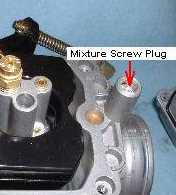jigglestick
Member
Update. After stepping away from the bike for awhile. (You have to do that sometimes) I sprayed some gumout in the low and main ports. Then blew some air thru. She runs like new again. Thanks guys.
Jack. The exploded view of the carb is great, but identifying each numbered part would be really nice. Anyway that you can post the key for that drawing? Specifically, I'm looking for the idle air mixture screw. I would like to take it out and clean out the ports, etc. It seems logical since I have to give it half choke to keep it running, that it isn't getting fuel on the idle circuit.


Update. After stepping away from the bike for awhile. (You have to do that sometimes) I sprayed some gumout in the low and main ports. Then blew some air thru. She runs like new again. Thanks guys.
The VOES was replaced with a MAP sensor on the twin cams. I would certainly pull the carb, disassemble, clean, set float level. If the A/F adjustment screw is still behind the plug, remove the plug so you can play with the A/F adjustment. If that doesn't correct things, pull the CPS and check for gunk.